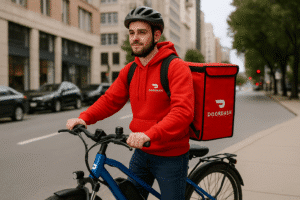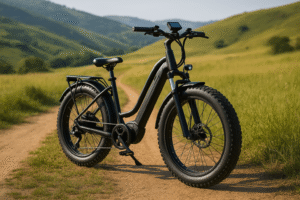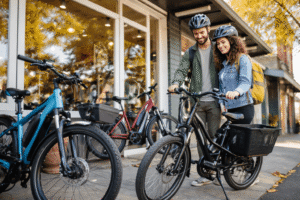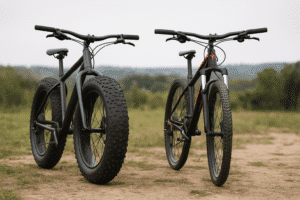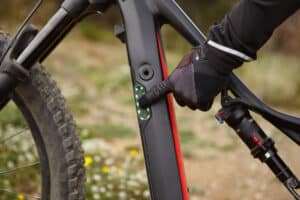If you’ve ever been stuck without your charger, you’ve probably wondered how to charge an e-bike battery without charger access.
The good news is there are a few safe workarounds you can use in emergencies or while traveling, as long as you know your battery’s voltage and use the right setup.
Key Summary:
To charge an e-bike battery without a charger, you can use a portable power station, a solar panel with a charge controller, a car battery with an inverter, or a universal adjustable power supply. The safest and simplest option is a portable power station matched to your battery’s voltage. Avoid makeshift chargers, random cables, or guessing the voltage, since these can damage the battery or create a fire risk.
Is It Possible to Charge an E-Bike Battery Without a Charger?
Yes, it’s possible to charge an e-bike battery without the original charger, but you need to be careful. Some alternative methods can work just fine in a pinch, but only if you match the right voltage and connection.
E-bike batteries aren’t like charging your phone — they need a certain amount of power, delivered in a specific way. If you try to charge it with the wrong setup, you could damage the battery or even cause a fire.
That’s why it’s important to understand your battery first and pick a method that makes sense for your situation.
Understanding Your E-Bike Battery First
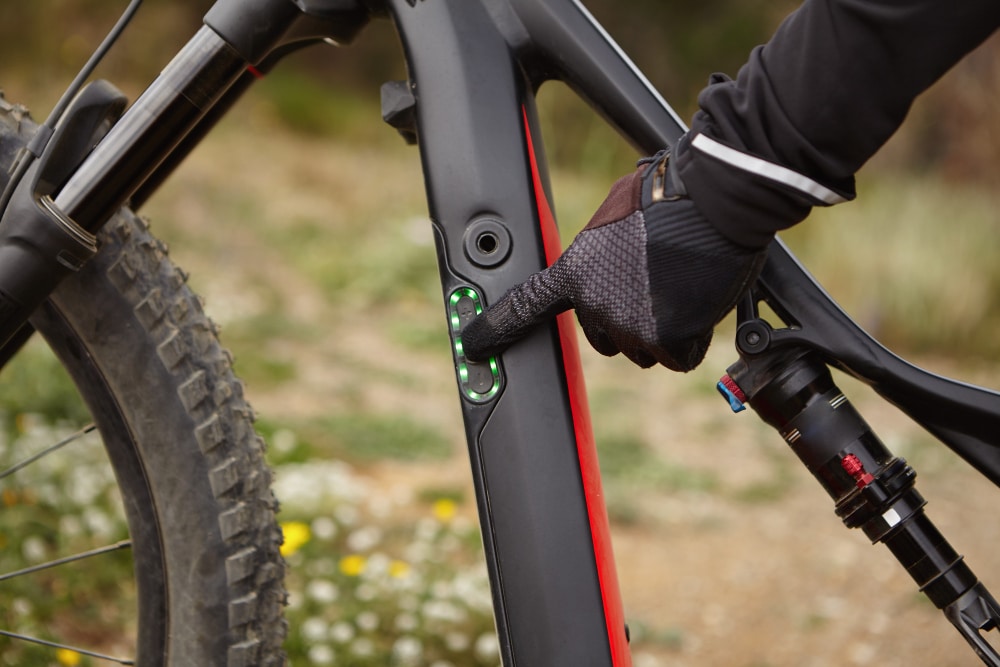
Before trying to charge your battery without a charger, it helps to know what you’re working with. Most e-bikes use lithium-ion batteries.
These are lightweight, long-lasting, and can pack a good amount of energy. But they’re also sensitive, and charging them the wrong way can shorten their life — or worse.
Check your battery label or manual. Look for the voltage (usually 36V or 48V) and the amp-hour (Ah) rating, which tells you how much energy the battery can store.
You’ll also want to note the type of connector it uses — this matters when figuring out how to plug it into something else.
The last thing to know is whether your battery has a built-in Battery Management System (BMS). This little chip helps protect the battery from overcharging or getting too hot.
Still, it doesn’t make the battery invincible — it just gives you a little extra wiggle room.
How to Charge an E-Bike Battery Without a Charger
Here are some ways you can charge an e-bike battery without the original charger:
- Use a portable power station with the right voltage output
- Connect your battery to a solar panel (with a charge controller)
- Use a car battery and an inverter
- Try a universal charger or adjustable power supply
- In emergencies, use a generator or public EV charging station
Now, let’s break these down.
1. Use a Portable Power Station
This is one of the most practical solutions, especially for travelers and vanlifers. Portable power stations are basically big batteries with AC and DC outlets. Some are even designed to handle electric bike charging directly.
Check that the power station provides the correct output — usually 42V or 54.6V, depending on your battery. If your e-bike has a removable battery, you can just plug it in using a compatible cable. Some brands even sell adapters just for this purpose.
This method is safe, reliable, and doesn’t require much technical knowledge.
2. Charge with a Solar Panel
Solar panels are great if you’re camping or living off the grid. But you’ll need more than just a panel; you’ll also need a charge controller and possibly an inverter, depending on your setup.
It works best when the sun is out for several hours. The charge controller helps regulate the voltage so you don’t fry your battery.
If you’re using a small portable panel, expect slower charging times. It’s not fast, but it works, especially if you’re parked somewhere for a while.
3. Use a Car Battery + Inverter
If you’ve got a car nearby, you can tap into its battery. You’ll need a DC to AC inverter that connects to the car’s battery (or 12V outlet) and converts that power into something your e-bike battery can use.
Then, if you have a compatible adapter or charger that works with AC, plug it in. Keep in mind: you don’t want to drain your car battery too far, or you might not be going anywhere later. Also, make sure the inverter has enough wattage to handle the job.
4. Try a Universal Charger or Adjustable Power Supply
These chargers let you dial in the exact voltage and current your battery needs. Sounds great, right? But here’s the catch: if you don’t know what you’re doing, you could easily fry the battery.
You’ll need to carefully match the voltage and connect the wires correctly. If you’re not confident with basic electronics, skip this one. But if you’ve done some DIY electronics before, it can be a handy backup method.
5. Use a Generator
A small portable generator can provide the power you need, especially if you’ve got your original charger but no wall outlet. Just fire up the generator and plug in.
It’s not the quietest option, and it’s obviously not the cleanest. But in an emergency or when camping off-grid, it can get the job done. Just double-check that the generator provides stable power; some cheaper ones don’t play nicely with sensitive electronics.
6. Public EV Charging Stations
Some cities have EV charging stations that allow you to charge small electric vehicles, including electric bikes, in some cases. You’ll likely need a special adapter, and not all stations will work with your battery.
But if you’re commuting and run low near an urban area, it’s worth keeping an eye out. Just don’t count on it as your main plan; these stations are built more for Teslas than two-wheelers.
What NOT to Do When Charging Without a Charger
If you need to charge your e-bike battery without the original charger, a few ideas might sound smart at first, but can actually cause serious problems. Here’s what you should steer clear of if you want to keep your battery safe.
- Don’t use a random laptop or phone charger. These don’t put out nearly enough power and are not built for high-capacity batteries. At best, it won’t work. At worst, it could short out your battery.
- Never guess the voltage or amperage. Plugging in without knowing the correct voltage is like filling a water balloon with a firehose; too much or too little can both cause problems. Always check the battery label first.
- Don’t charge with exposed wires or makeshift connectors. Loose or unshielded connections can cause sparks, heat, or electrical shorts. Keep it clean and secure.
- Avoid charging in wet or humid conditions. Moisture and electricity are a terrible mix. Always charge in a dry, shaded, and well-ventilated spot.
- Don’t walk away from a DIY charging setup. If you’re using a power supply or inverter setup, stay close and keep an eye on it. These methods don’t have the same safety features as official chargers.
Final Words
You can charge an e-bike battery without the original charger, but only if you do it carefully. Whether you’re using a portable power station, solar panel, or car inverter, the key is matching the right power output to your battery.
Don’t take chances with random chargers or exposed wires. Stick to methods that make sense for your situation, especially if you’re out on the road or off-grid.
Know your battery specs, keep things dry and safe, and always double-check connections before plugging anything in.
When in doubt, wait until you can charge properly; your e-bike (and your safety) will thank you for it.
FAQs
Can I charge my e-bike battery using a phone charger or USB-C?
No, phone chargers and USB-C ports don’t provide the voltage or current needed to charge an e-bike battery properly. It won’t charge, and trying to force it can damage your battery.
Is it safe to leave a DIY charging setup unattended?
Not really. If you’re using anything homemade or modified, it’s best to stay nearby while it’s charging. There’s more room for error, and things can go wrong fast if you’re not watching.
How long will solar take to charge my battery?
It depends on the size of your panel, how sunny it is, and your battery’s capacity. A small portable solar panel might take a full day or longer. A larger, more powerful setup can get it done in 4–6 hours with full sun.
Can I use a power tool battery to charge my e-bike?
It’s not recommended. Power tool batteries are designed differently, and wiring them to an e-bike battery is risky unless you’re very familiar with electronics. The voltage may not match, and it could damage both batteries.
What’s the safest alternative to a factory charger?
A portable power station that matches your battery’s voltage and uses a compatible connector is your best bet. It’s safe, practical, and doesn’t require hacking anything together.
Can you charge an e-bike battery through the USB port?
Technically, yes — but only for very low power trickle charging, and only if your e-bike battery supports it (most don’t). A USB port just doesn’t provide enough juice to charge a full battery unless it’s a special USB-C PD setup with higher output, and even then, it’s very slow.
Can I charge my e-bike battery with a power bank?
No, a standard power bank doesn’t provide the high voltage or current needed for an e-bike battery. Most e-bike batteries require 36V or 48V, while power banks usually output only 5V to 20V. Unless it’s a specialized high-voltage power station with the right adapter, it won’t work.
Is it safe to use solar panels for e-bike charging?
Yes, but only if you use a solar panel with a charge controller that regulates voltage. Directly connecting a panel to the battery can damage it. With the right setup, solar charging is safe, eco-friendly, and especially useful for camping or off-grid trips.
Michael Josh is a hands-on e-bike tester and reviewer at BoltBikers, known for putting every model through real-world rides before sharing his thoughts. With a sharp eye for performance, comfort, and build quality, he helps the team choose which bikes are worth featuring. Backed by years of experience in tech and gear reviews, Michael brings trusted, honest insights to help readers find the right e-bike for their needs.
